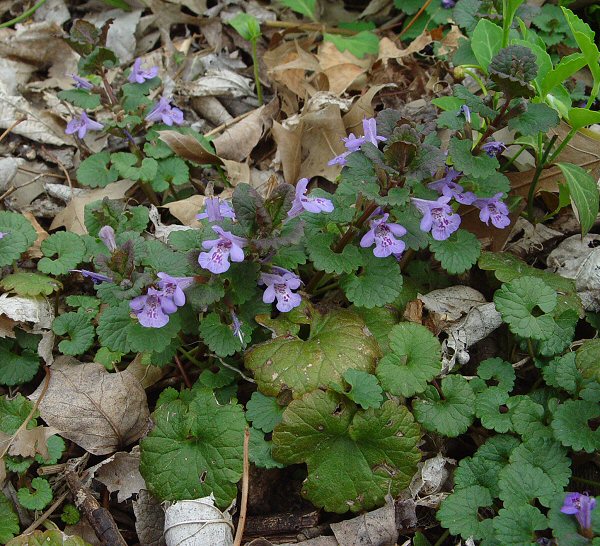Glechoma hederacea L.
Creeping Charlie, Ground Ivy

Introduced
CC = *
CW = 3
MOC = 54
© DETenaglia
Glechoma hederacea L.Creeping Charlie, Ground Ivy | |
 |
Introduced CC = * CW = 3 MOC = 54 |
© DETenaglia |
|
Family - Lamiaceae Habit - Perennial forb with fibrous roots, often forming mats. Stems - Prostrate, to 2 m long, sometimes with short, ascending branches, rooting at the nodes, mostly sharply 4-angled, branched, glabrous or minutely roughened along the angles, also usually with a line of longer bristly hairs at the nodes.
Leaves - Opposite, petiolate. Petioles retrorsely pubescent, reduced upward. Blades 1.0-2.5 cm long, 1.0-2.5 cm wide, broadly kidney-shaped to nearly circular, shallowly to deeply cordate at the base, rounded or broadly angled to a bluntly pointed tip, unlobed, the margins coarsely scalloped or bluntly toothed, sometimes also minutely hairy, the surfaces glabrous or less commonly sparsely short-hairy, the undersurface also with usually inconspicuous sessile glands.
Inflorescence - Axillary clusters of 2-6 flowers, secund. Pedicels 1-3 mm long.
Flowers - Bractlets hairlike, 1.0-1.5 mm long, linear to narrowly triangular, mostly shorter than the associated flower stalk. Calyces 4-7 mm long, slightly zygomorphic (the upper lobes slightly longer than the lower ones), symmetric at the base, more or less cylindric, the tube 15-nerved, glabrous in the mouth, the lobes shorter than the tube, oblong-elliptic, tapered to short-spinescent tips, sparsely to moderately pubescent with minute crinkly hairs on the outer surface. Corollas 10-18 mm long, zygomorphic, purplish blue to purple, the lower lip usually with lighter and darker mottling or spots, the outer surface moderately to densely pubescent, the tube funnelform, 2-lipped, the upper lip narrowly obcordate and straight, the lower lip with 3 spreading lobes, the larger central lobe shallowly notched at the tip, longer and much broader than the 2 lateral lobes, with a beard of fine spreading hairs internally near its base. Stamens 4, not or only slightly exserted, the filaments of 2 lengths, the anthers small, the connective short, the pollen sacs 2, spreading, white or purplish-to bluish-tinged. Ovary deeply lobed, the style appearing nearly basal from a deep apical notch. Style usually slightly exserted, with 2 slender purple branches at the tip.
Fruits - Dry schizocarps, separating into 2-4 nutlets, these 1.5-2.0 mm long, narrowly ovoid to oblong-ovoid or oblong-ellipsoid, the surface light brown to yellowish brown, glabrous, smooth or finely pebbled.
Flowering - March - July. Habitat - Bottomland and mesic forests, streambanks, bases of bluffs, lawns, gardens, railroads, roadsides, and shaded, disturbed areas. Origin - Native to Europe. Lookalikes - Malva neglecta. Other info. - This little plant is a ubiquitous sight in many parts of Missouri, particularly in eastern and southwestern counties, forming ground covering mats and creeping along the bases of other vegetation. It occurs throughout the continental U.S., but is much less common in the Great Plains and southwestern states. It prefers a somewhat shaded location and moist ground, but is highly tolerant of disturbance and mowing. It can be a serious pest in lawns and gardens. The plant has been cultivated as an ornamental, but this should be avoided in Missouri as the plant can be invasive in this region. It can grow up to 2 m in a single year, and can continue to elongate underneath leaf litter even during winter months. Crushed or mowed foliage produces an unpleasant odor. Photographs taken in Columbia, MO., 4-15-04 (DETenaglia); also near Labadie, Franklin County, MO, 4-26-2015 and 4-29-2021 (SRTurner). |